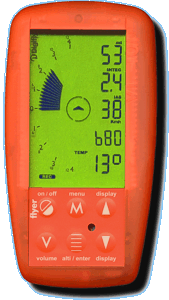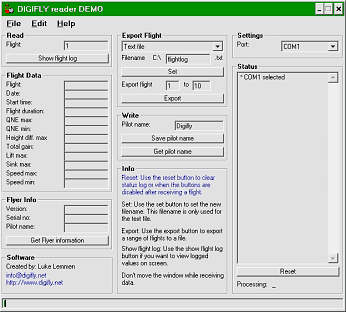Although Flyer variometer represents a basic instrument in a VL100 range of Digifly company, in comparison to functions and features of basic types Flytec 4005 and Brauniger AV-Pilot it offers more to pilots. Its size is fairly smaller and a leg-holder (velcro) is included inside a package (Brauniger AV-Pilot is packed without a leg-holder). What is more, a small flat plate (size 6x4cm) on the back side of Flyer will suit (after unscrewing and taking away the velcro) to fix into a paraglider's rack very well.

Handling
You don't need literally any user's guide even if you can choose an English, Czech or Poland version of the manuals included. You can always see on a display an abbreviation of the function name, which is just adjusted. That's why it's sufficient to remember that e.g. "V-up" stands for the speed of ascend, "V-dn" stands for the speed of descend, "Alti" stands for the setting of a height, etc. Naturally, Czech, Slovak or Poland people will prefer their native languages.
Feeding and Consumption
The instrument is powered by two AA cells and its electronic circuits can be powered by alkaline cells with a voltage of 1.5V or by charging cells (NiMH, NiCd) as well. Built digital voltmeter can measure a total voltage of the battery in Volts and a quantum of an energy in a percent. If you use charging NiMH or NiCd cells, you have to remember that this second piece of information (a percentage) seems to be lower. The progress of discharging is slightly different. Anyway, an automatic switching off is set to the treshold of 1.9V, which is the best limit for NiMH and NiCd cells.
The consumption varies between 23-25mA depending on a sound of an acoustic. Fully charged NiMH cells (capacity of 2300mAh) will keep for up to 100 hours, high-quality alkaline cells roughly twice more. A "Low Bat" indicator signs the last 20% of energy in cells, but it means alkaline cells. In case of using NiMH cells it will be rather less, a discharging curve is markedly steeper in its final part.
User's guide recommends to accomplish an exchange of the battery during one minute else a date and time is reset. But the tested instrument didn't reset time neither after 10 minutes and we found out the same result with the second instrument, which we pruingly tested the same way. So don't hurry please and take it easy.
Altimeter
The instrument uses three independently adjustable altimeters and you can reset two of them by pressing one button only. Maximum measurable height is 9999 meters and you can switch between meters and feet (ft). A reference atmospheric pressure of every altimeter can be adjust independently to a value of 300-1200hPa.
Variometer
An analogue variometer (a gauge imitation) measures a speed of an ascend or a descend in a range of +/-12m/s and what is more you can adjust a speed of reaction. Digifly company uses its own name "IntelliVario" but very similar function is built in Flytec 4005 and Brauniger AV-Pilot instruments. We can compare this to a car wheel hydraulic absorber, in this case we can adjust a solidity or switch it off completely.
A digital variometer measures a speed of an ascend or a descend in a range of +/-25m/s and shows it as a digital value. If you adjust its average interval to a value higher than zero the digital variometer changes itself to the average variometer, which calculates an average ascend during the adjustable time interval (1s-60s).
Acoustic
Listening the acoustic of the instrument (it's valid for types VL100 Runner, Cartesio and Graviter as well) I can't stand objectively impartial and I subjectively crow with delight. The sound is very similar to good-old Alibi in which I fell in love at one time (and maybe I ought to be ashamed a little bit). So no frequency sliding of a tone (yowling) but exactly defined frequency which changes from beep to beep and a variable length of timeout between beeps. Absolutely precise and great!
And what is more, you can change a way of the tone modulation in three different levels (0-2). The basic frequency shifts by this and a gradient of its variation as well. The sentence which I have written in the review of Alibi in a year of 1998: "You can turn also total shit thermal with a specific sound delight." is valid twice more here. A volume of the acoustic is adjustable in two different levels or you can turn it down completely. A treshold of the acoustic is independently adjustable for an ascend and a descend. And from a zero! After setting the acoustic treshold right to zero and not watching a display you can hear and recognize flying into the area with zero descending. In fact, there is ascending there and the value of it equals the speed of wing descend in a calm atmosphere. We'll minutely discuss this phenomenon in the next review of VL100 Runner, which is able to compute a real ascending (or descending) of surrounding masses of the air and what is more, independently to a speed of the flight. An airspeed probe must be connected in this case of course.
Temperature Stability
We couldn't stand up to a curiosity and the same way as Brauniger AV-Pilot at one time (and other instruments as well), VL100 Flyer was cooled down about 30°C.
|
Values of all three altimeters shifted down about 16 meters while a zero value of the variometer didn't move at all. This is the best temperature stability of variometer we've ever measured.
Time Measurement
Apart from a real time clock with a complete date (day, month and year) the instrument contains a chronometer, which is started either manually or automatically depending on the setting. This will be explained in a chapter "Flight Memory" later. A spiteful experiment to set a false date (30.2. or 31.9.) was unsuccessful, the instrument refused it.
Thermometer
On the display you can permanently watch a digital value of the temperature in units of °C or °F.
Barometer
The same way as the temperature value you can permanently display a value of the surrounding atmospheric pressure (in hPa) in the same position. You can calibrate the value of the barometer.
Calibration of Barometer
It's radically important to move the instrument to a point of a well known height above sea level (e.g. an elevation point) and to know simultaneously today's atmospherical pressure recalculated to the sea level. This value we put into the parameter "PRS1" and then we change an adjusting of a calibration parameter "Kbar" (a resolution of 0.1hPa) so that the altimeter "Alt1" shows the correct height above sea level of our point. This calibration can be faster if you know that changing the calibration parameter about +10 points (+1hPa) corresponds to -8 meters of a height.
Speedometer
After an airspeed probe connecting (not included) you can watch a speed of the flight up to a value of 150km/h. You can also adjust a treshold of the speed, which generates a low speed warning sound (a stall alarm). Besides this you can calibrate the displayed value, which is particularly useful in case of placing the probe close to a pilot's body where a stream of the air used to be decelerated.
Total Energy Compensation
An adduction of a joystick in a plane, an applaying the brakes of paraglider or a pushing away the speedbar of a hang-glider causes an ascending of the wing at the price of a slowing down the speed. As a result an ordinary varimeter indicates an ascending which is non-thermal of course. Flyer instrument can eliminate this effect if the airspeed probe is connected. Only you have to do is adjusting a compensate parameter to the proper value (a hang-glider about 65). Every pilot has to set this value for his wing experimentally during a flight in the calm air. He has to increase the value gradually as long as the variometer stops to react to the ascend, which is forced by the change of the speed.
Flight Memory
The instrument is able to memorize values of 100 flights. Values in a memory are: a maximum and a minimum height, a maximum ascend and a maximum descend, a maximum and a minimum speed of the flight, a sum of the heights gained during a flight, a duration of a flight and a date and time of the take-off.
A method of starting up the record is worked out fairly successfully (firmware version 7.1). You can choose in a menu, whether the record will start immediately after switching on or after pressing a button manually or whether the instrument recognize a take-off by a change of the height in time. A default setting of this third possibility is 2 meters during 4 seconds but you can change these values to different ones. Especially if you used to run into a forest shorly before the take-off!
Connection to PC
Thanks to a PC cable (not included) the instrument can establish a communication with a personal computer (both Flytec 4005 and Brauniger AV-Pilot miss this ability). You can download a communication software from producer's pages free of charge and new versions of firmware for all VL100 instruments as well. You can lucidly compare characteristics of Digifly variometers in this table.
As the communication software especially suits to downloading a baro-record and a tracklog (2D or 3D Logger) and VL Flyer has only the flight values memory available (Log-Book), it's much better to use Digifly Reader software to download values and work with them. This is a demo-version, which is limited up to 10 flights only. The full version, which allows to export the data to TXT and XLS files, you can order on SkyFly shop pages for the price 12 Euros roughly.

Conclusion
Even if Digifly company has been working since 1989, Digifly instruments quickly start to appear on Czech hills only presently. But if we have a look at functions and features of Digifly VL100 Flyer, we have to say it's positively better than both basic instruments Flytec 4005 and Brauniger AV-Pilot. Thanks to new technologies used, also the price is much lower. Maybe an enlightenment was missing here and a detail analysis of its characteristics too.
|

